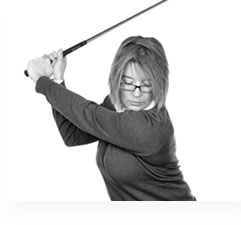 Natalie Adams – PGA Teaching Pro
Natalie Adams – PGA Teaching Pro
During this swing tip video we are going to have a look at how and why the golf ball curves in the air. So it's important to understand what’s making that happen, if you know what’s making that happen you can start to diagnose while you are swinging your golf club getting some feedback from the ball flight could start to diagnose what’s happened to the golf club and especially the club head during impact. So 85% of the reason that a golf ball will swing or fly in a particular direction is due to the club face. So that’s looking at where this part of the club is pointing as it connects with the ball. If the club face is pointing to the left, the ball is going to fly left.
If the club face is pointing to the right, the ball is going to fly right. 15% of the reason that a golf ball will fly in a particular way is due to the swing path of the club head. All that means is a direction that the club head is travelling in. So if we look at the red pole as being the target line, if the club head is travelling straight along the target line with the club face pointing in that direction, then the ball will fly straight. A ball will curve depend and the amount of curve will depend on the difference between the swing path of the club and the position that the club face was in. So if the club head travels from the far side of this red pole, onto the pole and then to the inside of that pole and the club face is pointing over to the right, that’s going to generate tilted axis spin.
So that’s going to make the ball spin but it won’t spin on its correct axis. So if we look at this golf ball here, if you hit this golf ball and the club head is travelling in the same direction that the club face is pointing, it will force the ball to spin on its axis like this. However if there is a difference between the path that the club head is travelling in and the position that the club is facing in, it will force the ball to spin off axis, it will have tilted axis spin. And this will now creates a movement and a curve into the air depending on which way the club face is pointing. So if we are looking a slice, a slice would be caused because the club face is pointing to the right of the target.
So the club face as it’s hitting the ball is pointing to the right of the target rather than down the red pole representing the target line. And the movement of the club head would have been from the outside of the line across it to the inside. So this will impact tilted axis spin which will force the ball to curve into the air. If we look at how a hook works, a hook moves the other way. A hook swing is right to left in the air and that would be the opposite way. So the club face is pointing to the left of the target but the club head is travelling from inside the target line to the outside of the target line. And that’s going to impart tilted-axis spin that now makes the ball fly right to left.
So learning what makes the ball curve in the air will give you valuable information when you are practicing because you can start to feed that back into what must have happened to the club face and the direction of the club head movement during your swing. If you understand that you’ll start to be able to straighten the shots out and improve your golf.





